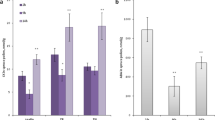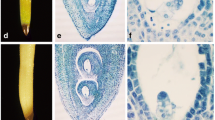Abstract
Proteins and peroxidases produced by the ovules and placenta of tobacco (Nicotiana tabacum L.) in response to compatible pollination were analyzed by two-dimensional polyacrylamide gel electrophoresis and by enzyme staining in flat-bed native isoelectric focusing gels. For two-dimensional gels, ovaries were sampled at 36 h after pollination, at which time pollen tubes have penetrated much of the length of the style but have not yet entered the ovary. At least 11 major proteins from pollinated ovaries had no detectable counterparts in unpollinated ovaries. These showed a range of molecular mass and pI. For peroxidase isozyme assays, ovaries were sampled at 0, 12, 24, 36 and 48 h after pollination. At 45–50 h, pollen tubes were beginning to enter the top of the ovary but could still be separated from the ovules and placenta during sampling. Ovules and placentae from unpollinated pistils showed only one form of peroxidase, whereas those from pollinated pistils showed additional isozymes at pH 5.4 and pH 10.0. Both new isozymes increased in staining intensity over the first 36 h after pollination. At 48 h, however, the acidic peroxidase had continued to increase, while the basic component had declined so as to be barely detectable. The observations are discussed in relation to accumulating evidence that some form of pollination-induced signal reaches the ovary ahead of the advancing pollen tubes. The nature of this signal and possible involvement of peroxidases are also briefly discussed.
Similar content being viewed by others
References
Bredemeijer GMM (1984) The role of peroxidases in pollen-pistil interactions. Theor Appl Genet 68:193–206
Bredemeijer GMM, Blaas J (1975) A possible role of a stylar peroxidase gradient in the rejection of incompatible growing pollen tubes. Acta Bot Neerl 24:37–48
Bredemeijer GMM, Blaas J (1983) Peroxidases in the cell walls and intercellular substance of pollinated Nicotiana alata styles. Acta Bot Neerl 32:457–466
Burg SP, Dijkman MJ (1967) Ethylene and auxin participation in pollen induced fading of Vanda orchid blossoms. Plant Physiol 42:1648–1650
Chandra Sekhar KN, DeMason DA (1988) Quantitative ultrastructure and protein composition of date palm (Phoenix dactylifera) seeds: a comparative study of endosperm versus embryo. Am J Bot 75:323–329
Chandra Sekhar KN, DeMason DA (1989) Differential activity of acid phosphatases from the endosperm and haustorium of date palm (Phoenix dactylifera) seeds. Can J Bot 67:1096–1102
Chandra Sekhar KN, Williams EG (1992) Nonradioactive in situ localisation of poly(A)+RNA during pollen development in anthers of tobacco (Nicotiana tabacum) Protoplasma 169:9–17
Deurenberg JJM (1976) In vitro protein synthesis with polysomes from unpollinated, cross-and self-pollinated Petunia ovaries. Planta 128:29–33
Deurenberg JJM (1977) Differentiated protein synthesis with polysomes from Petunia ovaries before fertilization. Planta 133:201–206
Dunbar BS (1987) Two-dimensional electrophoresis and immunological techniques. Plenum, New York
Gaspar T, Penel C, Castillo FJ, Greppin H (1985) A two-step control of basic and acidic peroxidases and its significance for growth and development. Physiol Plant 64:418–423
Gilissen LJW (1976) The role of the style as a sense organ in relation to wilting of the flower. Planta 132:201–202
Gilissen LJW (1977) Style controlled wilting of the flower. Planta 133:275–280
Gilissen LJW, Hoekstra FA (1984) Pollination induced corolla wilting in Petunia hybrida: rapid transfer through the style of a wilt inducing substance. Plant Physiol 75:496–498
Hall IV, Forsyth FR (1967) Production of ethylene by flowers following pollination and treatments with water and auxin. Can J Bot 45:1163–1166
Herrero M, Dickinson HG (1979) Pollen-pistil incompatibility in Petunia hybrida: changes in the pistil following compatible and incompatible intraspecific crosses. J Cell Sci 36:1–18
Hill SE, Stead AD, Nichols R (1987) Pollination induced ethylene and production of 1-aminocyclopropane-1-carboxylic acid by pollen of Nicotiana alata cv. White Burley. J Plant Growth Regul 6:1–13
Hoekstra FA, Weges R (1986) Lack of control by early pistillate ethylene of the accelerated wilting of Petunia flowers. Plant Physiol 80:403–408
Kenrick J, Knox RB (1981) Postpollination exudate from stigmas of Acacia (Mimosaceae). Ann Bot 48:103–106
Knox RB (1984) Pollen-pistil interactions. Encycl Plant Physiol 17:508–608
Linskens HF (1953) Physiologische und chemische Unterschiede zwischen selbst und fremdbestaubten Petunia-Griffeln. Naturwissenschaften 40:28–29
Linskens HF (1955) Physiologische Untersuchungen der Pollenschlauch-Hemmung selbststeriler Petunien. Z Bot 43:1–44
Linskens HF, Tupy J (1968) The amino acid pool in the style of self-incompatible strains of Petunia after self and cross pollination. Zuechter 36:151–158
Linskens HF, Spanjers AW (1973) Changes in the electrical potential in the transmitting tissue of Petunia styles after cross-and self-pollination. Incompat Newslett 3:81–85
Moncousin C, Gaspar T (1983) Peroxidase as a marker for rooting improvement of Cynara scolymus cultured in vitro. Biochem Physiol Pflanz 178:263–271
Nichols R (1977) Sites of ethylene production in the pollinated and unpollinated senescing carnation inflorescence. Planta 135:155–159
Nichols R, Frost C (1985) Wound-induced production of 1-aminocyclopropane-1-carboxylic acid and accelerated senescence of Petunia corollas. Sci Hortic 26:47–55
Reid MS, Fujino DW, Hoffman NE, Whitehead CS (1984) 1-Aminocyclopropane-1-carboxylic acid (ACC): the transmitted stimulus in flowers. J Plant Growth Regul 3:189–196
Sinyukhin AM, Britikov EA (1967) Action potentials in the reproductive system of plants. Nature 215:1278–1280
Spanjers AW (1978) Voltage variation in Lilium longiflorum pistils induced by pollination. Experientia 34:36–37
Spanjers AW (1981) Bioelectric potential changes in the style of Lilium longiflorum after self-and cross-pollination of the stigma. Planta 153:1–5
Williams EG, Knox RB (1982) Quantitative analysis of pollen tube growth in Lycopersicon peruvianum. J Palynol 18:65–74
Williams EG, Webb MC (1987) Enclosure of pollinated flowers weakens the gametophytic incompatibility response in Lycopersicon peruvianum. J Exp Bot 38:1756–1764
Author information
Authors and Affiliations
Rights and permissions
About this article
Cite this article
Chandra Sekhar, K.N., Heij, E.G. Changes in proteins and peroxidases induced by compatible pollination in the ovary of Nicotiana tabacum L. ahead of the advancing pollen tubes. Sexual Plant Reprod 8, 369–374 (1995). https://doi.org/10.1007/BF00243205
Received:
Accepted:
Issue Date:
DOI: https://doi.org/10.1007/BF00243205




